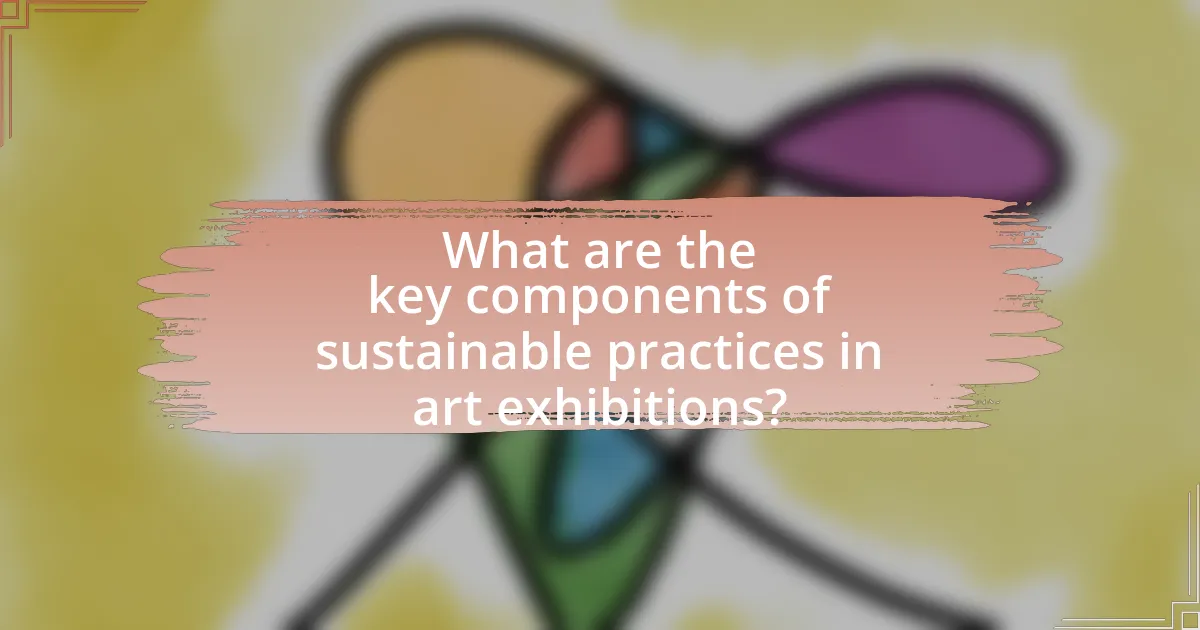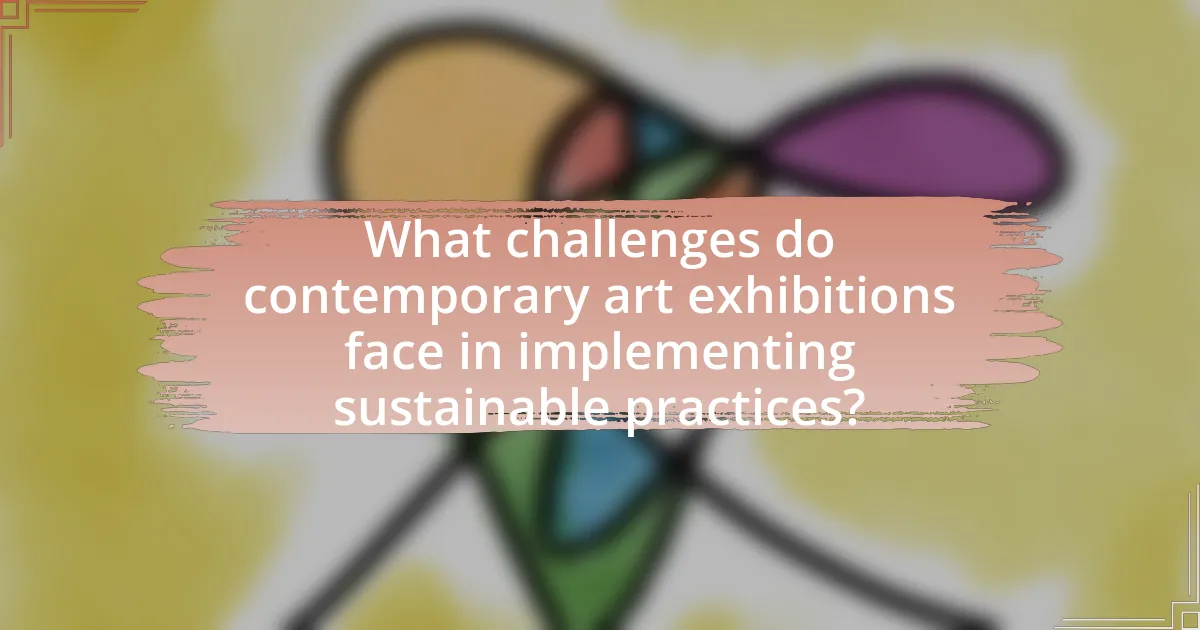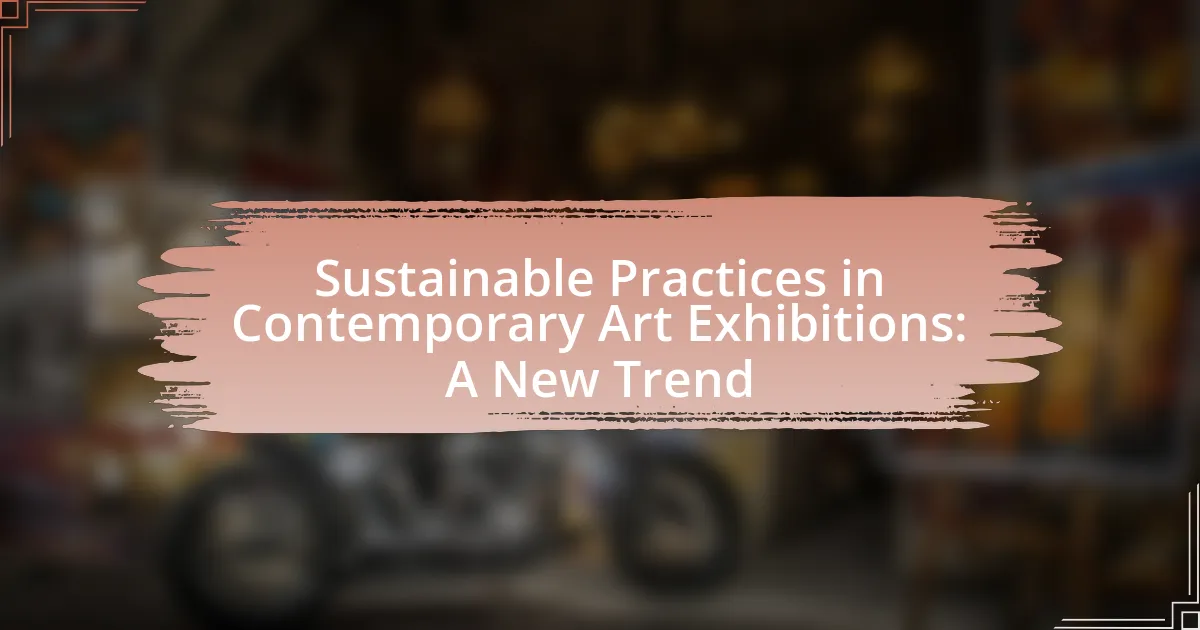Sustainable practices in contemporary art exhibitions focus on minimizing environmental impact while promoting social responsibility and economic viability. These practices include the use of eco-friendly materials, energy-efficient technologies, and waste reduction strategies, which differ significantly from traditional exhibition methods that often overlook ecological concerns. The article explores the materials commonly used in sustainable exhibitions, the impact of venue choices, and the role of artists in promoting sustainability. It also addresses audience expectations, the benefits of adopting sustainable practices, and the challenges faced by art institutions in implementing these initiatives. Additionally, it highlights innovative solutions and successful examples of sustainable exhibitions, providing practical steps for galleries to enhance their sustainability efforts.

What are Sustainable Practices in Contemporary Art Exhibitions?
Sustainable practices in contemporary art exhibitions refer to methods that minimize environmental impact while promoting social responsibility and economic viability. These practices include using eco-friendly materials for installations, implementing energy-efficient lighting, and reducing waste through recycling and composting initiatives. For instance, the use of biodegradable materials and sustainable sourcing of art supplies helps lower the carbon footprint of exhibitions. Additionally, many galleries are adopting digital platforms to reduce paper usage and enhance accessibility. Research indicates that integrating sustainability into art exhibitions not only fosters environmental awareness but also attracts a growing audience interested in eco-conscious initiatives.
How do these practices differ from traditional exhibition methods?
Sustainable practices in contemporary art exhibitions differ from traditional exhibition methods primarily through their focus on environmental responsibility and resource efficiency. Traditional methods often prioritize aesthetic appeal and visitor engagement without considering ecological impacts, leading to excessive waste and resource consumption. In contrast, sustainable practices incorporate eco-friendly materials, energy-efficient technologies, and waste reduction strategies, such as using recycled materials for installations and promoting digital formats to minimize physical resources. For example, the use of LED lighting in exhibitions significantly reduces energy consumption compared to conventional lighting, aligning with sustainability goals. This shift not only enhances the environmental footprint of exhibitions but also raises awareness among audiences about sustainability in the arts.
What materials are commonly used in sustainable art exhibitions?
Sustainable art exhibitions commonly utilize materials such as recycled paper, reclaimed wood, biodegradable plastics, and natural fibers. These materials are chosen for their minimal environmental impact and ability to reduce waste. For instance, recycled paper is often used for prints and installations, while reclaimed wood serves as a sustainable alternative for sculptures and display structures. Biodegradable plastics can replace traditional plastics in various applications, and natural fibers like cotton and hemp are favored for textiles and canvases. The use of these materials aligns with the growing emphasis on eco-friendly practices in contemporary art, reflecting a commitment to sustainability within the art community.
How does the choice of venue impact sustainability in art exhibitions?
The choice of venue significantly impacts sustainability in art exhibitions by influencing resource consumption, waste generation, and accessibility. Venues that prioritize sustainable architecture and energy-efficient systems reduce the carbon footprint associated with exhibitions. For instance, using existing buildings instead of new constructions minimizes material waste and energy use, as demonstrated by the Tate Modern in London, which repurposed a former power station, thereby conserving resources and reducing emissions. Additionally, venues located near public transportation enhance accessibility, encouraging visitors to use eco-friendly travel options, which further supports sustainability goals.
Why is sustainability becoming a trend in contemporary art?
Sustainability is becoming a trend in contemporary art due to increasing awareness of environmental issues and the desire for artists to engage with social responsibility. Artists are utilizing eco-friendly materials and practices to reflect concerns about climate change, resource depletion, and ecological degradation. For instance, a 2021 survey by Art Basel found that 70% of artists believe that sustainability is essential to their practice, indicating a significant shift towards environmentally conscious art-making. This trend not only resonates with audiences but also aligns with broader cultural movements advocating for sustainability, making it a vital aspect of contemporary artistic expression.
What role do artists play in promoting sustainable practices?
Artists play a crucial role in promoting sustainable practices by using their platforms to raise awareness and inspire action regarding environmental issues. Through their work, artists often incorporate sustainable materials and methods, demonstrating the feasibility of eco-friendly practices in the art world. For instance, many contemporary artists create installations using recycled materials, which not only highlight waste reduction but also engage audiences in conversations about sustainability. Additionally, exhibitions focused on environmental themes, such as “The Ocean After Nature” at the Museum of Modern Art, showcase how art can reflect and address ecological concerns, thereby influencing public perception and encouraging sustainable behaviors.
How do audience expectations influence sustainability in art exhibitions?
Audience expectations significantly influence sustainability in art exhibitions by driving curators and institutions to adopt eco-friendly practices. When audiences increasingly demand environmentally responsible exhibitions, galleries respond by implementing sustainable materials, reducing waste, and enhancing energy efficiency. For instance, a survey conducted by the Art Gallery of Ontario revealed that 70% of visitors prefer exhibitions that prioritize sustainability, prompting galleries to integrate green technologies and practices. This shift not only meets audience expectations but also fosters a culture of sustainability within the art community, encouraging artists and institutions to prioritize environmental considerations in their work.

What are the key components of sustainable practices in art exhibitions?
The key components of sustainable practices in art exhibitions include resource efficiency, waste reduction, and community engagement. Resource efficiency involves using sustainable materials and energy sources, such as LED lighting and recycled exhibition materials, to minimize environmental impact. Waste reduction focuses on implementing strategies like digital catalogues and reusable display systems to decrease physical waste generated during exhibitions. Community engagement emphasizes collaboration with local artists and organizations to promote sustainability awareness and foster a sense of shared responsibility for environmental stewardship. These components collectively contribute to a more sustainable approach in the art exhibition sector, aligning with broader environmental goals.
How can waste management be effectively implemented in exhibitions?
Waste management can be effectively implemented in exhibitions by integrating a comprehensive waste reduction strategy that includes recycling, composting, and minimizing single-use materials. This approach involves setting up clearly labeled recycling and compost bins throughout the exhibition space to encourage proper disposal of waste. For instance, the use of biodegradable materials for promotional items and signage can significantly reduce landfill contributions. Additionally, tracking waste generation and disposal methods can provide valuable data for improving future exhibitions. Research indicates that exhibitions adopting these practices can reduce waste by up to 50%, demonstrating the effectiveness of sustainable waste management strategies in this context.
What strategies can be used to minimize waste during art installations?
To minimize waste during art installations, artists and curators can implement strategies such as using sustainable materials, repurposing existing resources, and employing digital technologies. Sustainable materials, such as recycled or biodegradable options, reduce environmental impact and waste generation. Repurposing existing resources, like using leftover materials from previous installations, minimizes the need for new supplies and decreases waste. Additionally, employing digital technologies, such as virtual installations or augmented reality, can eliminate physical materials altogether, further reducing waste. These strategies align with the growing trend of sustainability in contemporary art exhibitions, emphasizing environmental responsibility while maintaining artistic integrity.
How can recycling be integrated into the exhibition process?
Recycling can be integrated into the exhibition process by utilizing recycled materials for displays, signage, and installations. This approach not only reduces waste but also promotes environmental awareness among visitors. For instance, exhibitions can feature artworks made from repurposed items, showcasing the creative potential of recycling. Additionally, organizers can implement recycling stations throughout the venue to encourage attendees to dispose of waste responsibly. According to a study by the National Endowment for the Arts, incorporating sustainable practices, including recycling, can enhance visitor engagement and support the overall mission of promoting environmental stewardship in the arts.
What are the benefits of adopting sustainable practices in art exhibitions?
Adopting sustainable practices in art exhibitions significantly reduces environmental impact and promotes social responsibility. These practices, such as using eco-friendly materials and minimizing waste, contribute to a lower carbon footprint, which is crucial in combating climate change. For instance, a study by the Art Gallery of Ontario found that implementing sustainable practices can reduce energy consumption by up to 30%. Additionally, sustainable exhibitions can enhance the reputation of galleries and artists, attracting a growing audience that values environmental consciousness. This shift not only fosters community engagement but also aligns with global sustainability goals, making art more relevant in today’s context.
How do sustainable practices enhance the visitor experience?
Sustainable practices enhance the visitor experience by creating a more engaging and responsible environment that resonates with contemporary values. When art exhibitions incorporate eco-friendly materials, energy-efficient technologies, and waste reduction strategies, they not only minimize their environmental impact but also foster a sense of community and awareness among visitors. For instance, studies show that 70% of visitors prefer venues that demonstrate sustainability, indicating that such practices can lead to increased visitor satisfaction and loyalty. By aligning with the growing demand for environmental consciousness, exhibitions can attract a broader audience and enhance the overall experience through educational initiatives and interactive displays that highlight sustainability efforts.
What economic advantages can galleries gain from sustainability?
Galleries can gain significant economic advantages from sustainability by reducing operational costs and attracting a broader audience. Implementing sustainable practices, such as energy-efficient lighting and waste reduction strategies, can lower utility bills and operational expenses. For instance, a study by the Carbon Trust found that organizations can save up to 20% on energy costs through energy efficiency measures. Additionally, galleries that prioritize sustainability often enhance their brand image, appealing to environmentally conscious consumers and increasing visitor numbers. This trend is supported by a report from the National Endowment for the Arts, which indicates that 72% of art consumers prefer to support organizations that demonstrate environmental responsibility. Thus, sustainability not only cuts costs but also drives revenue through increased patronage.

What challenges do contemporary art exhibitions face in implementing sustainable practices?
Contemporary art exhibitions face significant challenges in implementing sustainable practices, primarily due to logistical constraints, financial limitations, and the complexity of materials used. Logistical constraints arise from the need for specialized transportation and installation methods that minimize environmental impact, which can be difficult to coordinate. Financial limitations often hinder the adoption of sustainable materials and technologies, as many exhibitions operate on tight budgets. Additionally, the complexity of materials used in contemporary art, such as synthetic substances and non-recyclable components, complicates efforts to ensure sustainability. These factors collectively impede the integration of eco-friendly practices in the art exhibition sector.
How can funding and resources impact sustainability efforts?
Funding and resources significantly impact sustainability efforts by providing the necessary financial support and materials to implement eco-friendly practices. Adequate funding enables organizations to invest in sustainable technologies, such as renewable energy sources and waste reduction systems, which are essential for minimizing environmental footprints. For instance, a study by the National Endowment for the Arts found that art organizations with dedicated sustainability funding were able to reduce their carbon emissions by up to 30% over five years. Additionally, resources such as skilled personnel and sustainable materials facilitate the development and execution of innovative projects that prioritize environmental stewardship. Therefore, the availability of funding and resources directly correlates with the effectiveness and scope of sustainability initiatives in various sectors, including contemporary art exhibitions.
What are common misconceptions about the costs of sustainable practices?
Common misconceptions about the costs of sustainable practices include the belief that they are always more expensive than traditional methods. In reality, sustainable practices can lead to long-term cost savings through energy efficiency, waste reduction, and resource conservation. For instance, a study by the World Economic Forum found that companies implementing sustainable practices can reduce operational costs by up to 20% over time. Additionally, initial investments in sustainable technologies often yield significant returns, as seen in the renewable energy sector, where the cost of solar energy has dropped by over 80% since 2010, making it more accessible and cost-effective.
How can collaboration among artists, curators, and institutions overcome these challenges?
Collaboration among artists, curators, and institutions can effectively overcome challenges in sustainable practices by pooling resources, sharing expertise, and fostering innovative solutions. When artists work alongside curators and institutions, they can create exhibitions that prioritize eco-friendly materials and practices, as seen in initiatives like the “Green Art Lab” project, which emphasizes sustainability in art production and exhibition. This collaborative approach not only enhances the visibility of sustainable practices but also encourages a collective commitment to reducing environmental impact, as demonstrated by the increased adoption of sustainable methods in major art institutions globally.
What innovative solutions are being explored in sustainable art exhibitions?
Innovative solutions being explored in sustainable art exhibitions include the use of biodegradable materials, energy-efficient lighting, and digital art formats that reduce physical waste. Biodegradable materials, such as plant-based plastics and recycled paper, are increasingly utilized for installations and promotional materials, minimizing environmental impact. Energy-efficient lighting, including LED technology, significantly lowers energy consumption during exhibitions. Additionally, digital art formats, such as virtual reality and augmented reality, eliminate the need for physical artworks, further reducing resource use and waste. These practices reflect a growing commitment within the art community to address environmental concerns while maintaining artistic expression.
How is technology being utilized to promote sustainability in art?
Technology is being utilized to promote sustainability in art through digital platforms, eco-friendly materials, and innovative production techniques. Digital platforms enable artists to reach wider audiences without the need for physical exhibitions, reducing carbon footprints associated with travel and logistics. Eco-friendly materials, such as biodegradable paints and recycled substrates, are increasingly used in art creation, minimizing environmental impact. Additionally, innovative production techniques, like 3D printing with sustainable materials, allow for efficient resource use and waste reduction. These practices collectively contribute to a more sustainable art ecosystem, aligning with the growing emphasis on environmental responsibility in contemporary art.
What examples of successful sustainable exhibitions can be highlighted?
The Venice Biennale is a prominent example of a successful sustainable exhibition, showcasing eco-friendly practices in contemporary art. In 2021, the Biennale implemented a range of sustainability measures, including the use of renewable energy sources, waste reduction strategies, and the promotion of artworks that address environmental issues. Additionally, the Museum of Modern Art (MoMA) in New York has hosted exhibitions like “The Future is Now,” which emphasized sustainable design and featured artists who focus on ecological themes. These initiatives demonstrate a commitment to sustainability in the art world, aligning with global efforts to address climate change and promote environmental awareness.
What practical steps can art institutions take to implement sustainable practices?
Art institutions can implement sustainable practices by adopting energy-efficient technologies, utilizing sustainable materials, and promoting eco-friendly transportation options for visitors. For instance, installing LED lighting and energy-efficient HVAC systems can significantly reduce energy consumption, as studies show that LED lights use up to 75% less energy than traditional incandescent bulbs. Additionally, sourcing materials from local and sustainable suppliers minimizes the carbon footprint associated with transportation and supports local economies. Encouraging visitors to use public transport or providing bike racks can further reduce the environmental impact of exhibitions. These steps not only contribute to sustainability but also align with the growing public demand for environmentally responsible practices in the arts.
How can galleries educate their staff and artists about sustainability?
Galleries can educate their staff and artists about sustainability through structured training programs and workshops focused on sustainable practices in art. These educational initiatives can include expert-led sessions on eco-friendly materials, energy-efficient exhibition design, and waste reduction strategies. For instance, the Museum of Modern Art (MoMA) has implemented sustainability training for its staff, emphasizing the importance of reducing carbon footprints in art handling and exhibition processes. Additionally, galleries can provide resources such as guides and online courses that cover sustainability topics relevant to the art world, ensuring that both staff and artists are informed and engaged in sustainable practices.
What resources are available for institutions looking to adopt sustainable practices?
Institutions looking to adopt sustainable practices can access various resources, including guidelines from organizations like the American Alliance of Museums, which provides a framework for sustainability in museum operations. Additionally, the Sustainable Arts Foundation offers grants and support specifically for arts organizations aiming to implement eco-friendly initiatives. Research studies, such as “Sustainability in the Arts: A Review of Current Practices” published in the Journal of Cultural Heritage Management and Sustainable Development, provide insights and case studies on successful sustainable practices in the arts sector. These resources collectively offer practical strategies, funding opportunities, and research-backed insights to facilitate the adoption of sustainability in contemporary art exhibitions.


